Hampstead
Coordinates: 51°33′15″N 0°10′28″W / 51.5541°N 0.1744°W
Hampstead (/ˈhæmpstɪd/ or /-stɛd/), commonly known as Hampstead Village, is an area of London, England, 4 miles (6.4 km) northwest of Charing Cross. Part of the London Borough of Camden, it is known for its intellectual, liberal, artistic, musical and literary associations and for Hampstead Heath, a large, hilly expanse of parkland. It has some of the most expensive housing in the London area. The village of Hampstead has more millionaires within its boundaries than any other area of the United Kingdom.[1]
History
Toponymy
The name comes from the Anglo-Saxon words ham and stede, which means, and is a cognate of, the Modern English "homestead".
To 1900

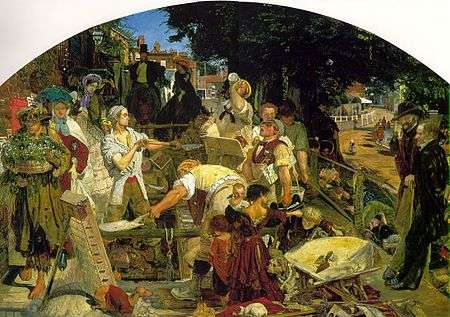
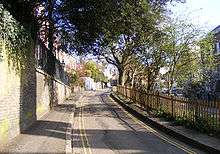
Early records of Hampstead can be found in a grant by King Ethelred the Unready to the monastery of St. Peter's at Westminster (AD 986), and it is referred to in the Domesday Book (1086)[2] as being in the hundred of Ossulstone.
The growth of Hampstead is generally traced back to the 17th century. Trustees of the Well started advertising the medicinal qualities of the chalybeate waters (water impregnated with iron) in 1700. Although Hampstead Wells was initially most successful and fashionable, its popularity declined in the 1800s due to competition with other fashionable London spas. The spa was demolished in 1882, although a water fountain was left behind.
Hampstead started to expand following the opening of the North London Railway in the 1860s (now the London Overground with passenger services operated by Transport for London), and expanded further after the Charing Cross, Euston & Hampstead Railway opened in 1907 (now part of London Underground's Northern line) and provided fast travel to central London.
Much luxurious housing was created during the 1870s and 1880s, in the area that is now the political ward of Frognal & Fitzjohns. Much of this housing remains to this day.
20th century
In the 20th century, a number of notable buildings were created including:
- Hampstead tube station (1907), the deepest station on the Underground network
- Isokon building (1932)
- Hillfield Court (1932)
- 2 Willow Road (1938)
- Swiss Cottage Central Library (1964)
- Royal Free Hospital (mid-1970s)
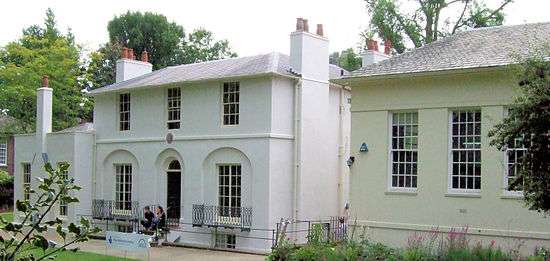
Cultural attractions in the area include the Freud Museum, Keats House, Kenwood House, Fenton House, the Isokon building, Burgh House (which also houses Hampstead Museum), and the Camden Arts Centre. The large Victorian Hampstead Library and Town Hall was recently converted and extended as a creative industries centre.
On 14 August 1975 Hampstead entered the UK Weather Records with the Highest 155-min total rainfall at 169 mm. As of November 2008 this record remains.
Politics

Hampstead became part of the County of London in 1889 and in 1899 the Metropolitan Borough of Hampstead was formed. The borough town hall on Haverstock Hill, which was also the location of the Register Office, can be seen in newsreel footage of many celebrity civil marriages. In 1965 the metropolitan borough was abolished and its area merged with that of the Metropolitan Borough of Holborn and the Metropolitan Borough of St Pancras to form the modern-day London Borough of Camden. Hampstead is part of the Hampstead and Kilburn constituency, formed at the 2010 general election. It was formerly part of the Hampstead and Highgate constituency. From 1992 to 2015 the Member of Parliament was the former actress Glenda Jackson of the Labour Party. Glenda Jackson retired at the 2015 general election and was succeeded by Tulip Siddiq.
Since May 2015 the area has been represented on Camden Council by Conservative Party councillors Tom Currie, Oliver Cooper and Stephen Stark.
Hampstead Liberalism
The area has a significant tradition of educated liberal humanism, often referred to (often disparagingly) as "Hampstead Liberalism". In the 1960s, the figure of the Hampstead Liberal was notoriously satirised by Peter Simple of the Daily Telegraph in the character of Lady Dutt-Pauker, an immensely wealthy aristocratic socialist whose Hampstead mansion, Marxmount House, contained an original pair of Bukharin's false teeth on display alongside precious Ming vases, neo-constructivist art, and the complete writings of Stalin.[3] Michael Idov of The New Yorker stated that the community "was the citadel of the moneyed liberal intelligentsia, posh but not stuffy."[4] As applied to an individual, the term "Hampstead Liberal" is not synonymous with "champagne socialist" but carries some of the same connotations. The term is also rather misleading. As of 2016, all the component wards of Hampstead (Swiss Cottage, Frognal and Fitzjohns, Hampstead Town and Belsize) elect a full slate of Conservative councillors. Whilst Swiss Cottage is a competitive-marginal ward between the Conservatives and Labour and whilst Belsize is a competitive-marginal ward between the Conservatives and the Liberal Democrats, the area of Hampstead Village itself (Hampstead Town), as well as Frognal and Fitzjohns are safe Conservative wards.
Places of interest
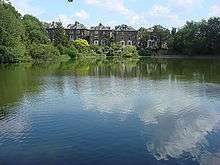
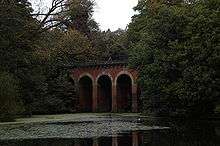
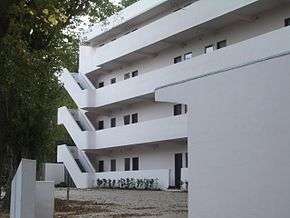
Sites
To the north and east of Hampstead, and separating it from Highgate, is London's largest ancient parkland, Hampstead Heath, which includes the well-known and legally-protected view of the London skyline from Parliament Hill. The Heath, a major place for Londoners to walk and "take the air", has three open-air public swimming ponds; one for men, one for women, and one for mixed bathing, which were originally reservoirs for drinking water and the sources of the River Fleet. The bridge pictured is known locally as 'The Red Arches' or 'The Viaduct', built in fruitless anticipation of residential building on the Heath in the 19th century.
Local activities include major open-air concerts on summer Saturday evenings on the slopes below Kenwood House, book and poetry readings, fun fairs on the lower reaches of the Heath, period harpsichord recitals at Fenton House, Hampstead Scientific Society and Hampstead Photographic Society.
The largest employer in Hampstead is the Royal Free Hospital, Pond Street, but many small businesses based in the area have international significance. George Martin's AIR recording studios, in converted church premises in Lyndhurst Road, is a current example, as Jim Henson's Creature Shop was before it relocated to California.
The area has some remarkable architecture, such as the Isokon building in Lawn Road, a Grade I listed experiment in collective housing, once home to Agatha Christie, Henry Moore, Ben Nicholson and Walter Gropius. It was recently restored by Notting Hill Housing Trust.
Churches and synagogues
- Christ Church – Hampstead Square, NW3 1AB[5]
- Heath Street Baptist Church, Heath Street, NW3 1DN[6]
- St. Andrew's United Reformed Church, Frognal Lane, NW3 7DY[7]
- St John-at-Hampstead – Church Row, NW3 6UU[8]
- St John's Downshire Hill – Downshire Hill, NW3 1NU[9]
- St Luke's – Kidderpore Avenue, NW3 7SU[10][11]
- St Mary's Church – 4 Holly Place, NW3 6QU[12][13]
- Rosslyn Hill Unitarian Chapel – Pilgrim's Place, NW3 1NG
- Village Shul, Hampstead's only synagogue, which was founded in 2006 and has occupied the former New End Theatre since 2011[14]
Museums
- Fenton House – Hampstead Grove, Hampstead, London, NW3 6SP[15]
- Freud Museum – 20 Maresfield Gardens, Hampstead, London, NW3 5SX[16]
- Burgh House & Hampstead Museum – New End Square, Hampstead, London, NW3 1LT[17]
- Keats House Museum – Keats Grove, Hampstead, London, NW3 2RR[18]
- Kenwood House – Hampstead Lane, Hampstead, London, NW3 7JR[19]
Theatres and cinemas
- Everyman Cinema – 5 Holly Bush Vale, Hampstead, London, NW3 6TX[20]
- Hampstead Theatre – Eton Avenue, Swiss Cottage, London, NW3 3EU[21]
- Pentameters Theatre – 28 Heath Street, Hampstead, London, NW3 6TE[22]
Public houses
Hampstead is well known for its traditional pubs, such as The Holly Bush, gas-lit until recently;[23][24] the Spaniard's Inn, Spaniard's Road, where highwayman Dick Turpin took refuge; The Old Bull and Bush in North End; and The Old White Bear (formerly Ye Olde White Bear).[25] Jack Straw's Castle, on the edge of the Heath near Whitestone Pond, has now been converted into residential flats. Others include:
- The Flask – 14 Flask Walk, Hampstead, London, NW3 1HE[26]
- Freemasons Arms – 32 Downshire Hill, Hampstead, London, NW3 1NT[27]
- The Duke of Hamilton – 23–25 New End, Hampstead, London, NW3 1JD[28]
- The Horseshoe (formerly The Three Horseshoes) – 28 Heath Street, Hampstead, London, NW3 6TE[29]
- King William IV (aka KW4) – 77 Hampstead High Street, Hampstead, London, NW3 1RE[30]
- The Magdala – 2a South Hill Park, Hampstead, London, NW3 2SB[31][32]
- The Garden Gate – 14 South End Road, Hampstead, London, NW3 2QE[33]
Restaurants
Hampstead has an eclectic mix of restaurants ranging from French to Thai. Notable and longstanding are La Gaffe, Gaucho Grill, Jin Kichi, Tip Top Thai, Villa Bianca and, in May 2016, Patara. After over a decade of controversy and legal action from local residents, McDonald's was finally allowed to open in Hampstead in 1992, after winning its right in court, and agreeing to a previously unprecedented re-design of the shop front, reducing the conspicuousness of its facade and logo,[34] but closed in November 2013.[35]
Schools
Film locations

Hampstead's rural feel lends itself for use on film; a notable example being The Killing of Sister George (1968) starring Beryl Reid and Susannah York. The opening sequence has Reid's character June wandering through the streets and alleyways of Hampstead, west of Heath Street, around The Mount Square. The Marquis of Granby pub, in which June drinks at the opening of the film, was actually The Holly Bush,[23] at 22 Holly Mount. Another example is The Collector (1965), starring Terence Stamp and Samantha Eggar, where the kidnap sequence is set in Mount Vernon.
Some scenes from An American Werewolf in London (1981) are shot on Hampstead Heath, Well Walk and Haverstock Hill. Harry and Judith are killed in Hampstead Heath, behind The Pryors on East Heath Road. Before David kills them, Harry and Judith get out of the taxi on East Heath Road at Well Walk.
More recently Kenwood House is the set of the "film-within-the-film" scene of Notting Hill (1999). Outdoor scenes in The Wedding Date (2005), starring Debra Messing, feature Parliament Hill Fields on the Heath, overlooking west London. Parliament Hill also features in Notes on a Scandal (2006) together with the nearby areas of Gospel Oak and Camden Town. Four Weddings and a Funeral (1994) features the old Hampstead Town Hall on Haverstock Hill. The cult film Scenes of a Sexual Nature (2006) was filmed entirely on Hampstead Heath, covering various picturesque locations such as the 'Floating Gardens' and Kenwood House.
A musical specifically focusing on the area, Les Bicyclettes de Belsize (1968), tells the story of a young man's cycle journey around Hampstead. After crashing into a billboard poster, he falls in love with the fashion model depicted on it.
Demography
The 2011 census showed that the population of Hampstead Town ward was 80% white (54% British, 24% Other, 2% Irish). The largest non-white group, Other Asian, claimed 4%. 35% was Christian, 27% irreligious and 10% Jewish.[36] The whole town had a population of 60,918 in 2011 and includes the wards of Frognal, Hampstead Town, Belsize, West Hampstead and Swiss Cottage.[37]
Transport
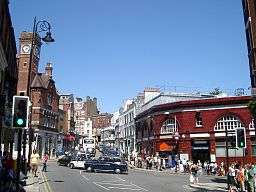
Hampstead has a major bus terminus known as Hampstead Heath located in South End Green. Its most frequent service is Route 24 which for over 100 years has linked this area with the West End, Victoria and Grosvenor Road in Pimlico. Bus routes that currently serve Hampstead are: 24 46 168 210 268 603 C11 and N5.
Nearest tube stations
The nearest London Underground stations are Hampstead and Belsize Park on the Northern line and Swiss Cottage and Finchley Road on the Jubilee line. The stations are within Travelcard Zone 2. Hampstead is the boundary with Travelcard Zone 3. Construction of North End tube station was started but not completed.
Nearest railway station
Hampstead Heath railway station is situated by South End Green while Finchley Road & Frognal station is on the western side of Hampstead. Both stations are part of the London Overground network.
Nearest hospital
Nearest places
Notable residents
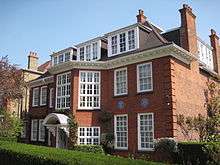
Hampstead has long been known as a residence of the intelligentsia, including writers, composers, ballerinas and intellectuals, actors, artists and architects – many of whom created a bohemian community in the late 19th century. After 1917, and again in the 1930s, it became base to a community of avant garde artists and writers and was host to a number of émigrés and exiles from the Russian Revolution and Nazi Europe.
Blue plaques
There are at least 60 English Heritage blue plaques in Hampstead commemorating the many diverse personalities that have lived there.[38]
Cultural references
- Hampstead is referred to in the song "Young Conservatives" by The Kinks and in "Cross-Eyed Mary", "Mother Goose" and "A Small Cigar" by Jethro Tull.
- Hampstead is referenced in a Monty Python sketch where a famous playwright (with a northern accent and working-class look) sarcastically remarks to his son (who works in a mine): "Hampstead wasn't good enough for you, eh? You had to go poncin' off to Barnsley".
- Hampstead is the fictional location of Lucy Westenra's tomb in Bram Stoker's novel Dracula. Lucy lured children to Hampstead Heath at night to drink their blood. During the course of their investigation, Drs. Van Helsing and Seward dined at Jack Straw's Castle and caught a cab near Spaniards Inn.
- In Charles Dickens' comic novel The Pickwick Papers, Pickwick writes a scientific paper, "Speculations on the Source of Hampstead Ponds", referring to the ponds on Hampstead Heath.
- Hampstead is mentioned in the title of the book Black Swine in the Sewers of Hampstead by Thomas Boyle. The book, published in 1990, examines the development in mid-Victorian Britain of sensationalism in the popular press and of sensation novels in literature, and the nature and causes of both.
- In The Pretenders' song "Middle of the Road", Chrissie Hynde sings "Past corrugated tin shacks holed up with kids, man, I don't mean a Hampstead nursery."
- 23 Highgate Street, Hampstead is the location of Dr Milena Gardosh's home in Basic Instinct 2.
- Hampstead was the subject of a satirical computer adventure game, released in 1984.[39]
Local newspapers
The local newspapers, as of 2014, were the Hampstead and Highgate Express[40]—known locally as the "Ham and High"—and the free Camden New Journal. The area is also home to the left-wing Labour magazine Tribune and the satirical magazine Hampstead Village Voice.
See also
References and notes
- ↑ Wade, David, "Whatever happened to Hampstead Man?". The Daily Telegraph, 8 May 2004 (Retrieved 3 March 2016)
- ↑ Anna Powell-Smith. "Hampstead | Domesday Book". Domesdaymap.co.uk. Retrieved 29 October 2015.
- ↑ The Stretchford Chronicles, Michael Wharton, (London, 1980), pages 216, 236, 284
- ↑ Idov, Michael. "The Demon Blogger of Fleet Street." New York Magazine. 26 September 2010. Retrieved 3 August 2014.
- ↑ A Church Near You (16 January 2015). "Christ Church Hampstead, Hampstead - London | Diocese of London". Achurchnearyou.com. Retrieved 29 October 2015.
- ↑ "Heath Street Baptist Church". Heathstreet.org. 8 June 2014. Retrieved 29 October 2015.
- ↑ St. Andrew's United Reformed Church
- ↑ "St John-at-Hampstead". aChurchNearYou.com (Retrieved 18 June 2009)
- ↑ "St John's Downshire Hill". SJDH.org (Retrieved 18 June 2009)
- ↑ "St Luke's, Hampstead". stlukeshampstead.org (Retrieved 15 August 2010)
- ↑ St Luke's was built with financial help from Anne Dudin Brown.
- ↑ "St Mary's Chapel". RCDOW.org.uk (Retrieved 18 June 2009)
- ↑ St Mary's Chapel was founded by Roman Catholic refugees from the French Revolution.
- ↑ "The Village Shul". The Village Shul. Retrieved 29 October 2015.
- ↑ "Fenton House". NationalTrust.org.uk (Retrieved 18 June 2009)
- ↑ "Freud Museum". HeritageBritain.com (Retrieved 18 June 2009)
- ↑ "Burgh House & Hampstead Local History Museum". AboutBritain.com (Retrieved 18 June 2009)
- ↑ "Keats House Museum". AboutBritain.com (Retrieved 18 June 2009)
- ↑ "Kenwood House". English-Heritage.org.uk (Retrieved 18 June 2009)
- ↑ "Everyman Cinema Club". LondonNet.co.uk (Retrieved 18 June 2009)
- ↑ "Hampstead Theatre". VisitLondon.com (Retrieved 18 June 2009)
- ↑ "Pentameters Theatre". LondonNet.co.uk (Retrieved 18 June 2009)
- 1 2 "The Killing of Sister George film locations". Movie-Locations.com (Retrieved 18 June 2009)
- ↑ "The Holly Bush". FancyaPint.com (Retrieved 18 June 2009)
- ↑ "Ye Olde White Bear". FancyaPint.com (Retrieved 18 June 2009)
- ↑ "The Flask". FancyaPint.com. (Retrieved 13 April 2010)
- ↑ "Freemasons Arms". FancyaPint.com (Retrieved 18 June 2009)
- ↑ "The Duke of Hamilton". FancyaPint.com (Retrieved 18 June 2009)
- ↑ "The Horseshoe". FancyaPint.com (Retrieved 18 June 2009)
- ↑ "King William IV". FancyaPint.com (Retrieved 18 June 2009)
- ↑ "The Magdala". FancyaPint.com (Retrieved 18 June 2009)
- ↑ Ruth Ellis, the last woman hanged in England, killed her lover David Blakely outside The Magdala in 1955. (Retrieved 18 June 2009)
- ↑ "The Garden Gate". FancyaPint.com (Retrieved 18 June 2009)
- ↑ LETTER FROM LONDON; Hampstead Braces for a Big Mac Attack, The Washington Post | 4 November 1992 | Eugene Robinson
- ↑ Wright, Paul (1 November 2013). 'McDonald’s in Hampstead High Street to close after 21 years'. Ham & High.
- ↑ http://www.ukcensusdata.com/hampstead-town-e05000135
- ↑ http://www.ukcensusdata.com/camden-e09000007#sthash.HZ81kFvl.dpbs
- ↑ "Search Blue Plaques". Blue plaques search – Hampstead. English Heritage. Retrieved 6 September 2014.
- ↑ "Hampstead". World of Spectrum. Retrieved 29 October 2015.
- ↑ Title -- MrMrsMsMiss First name: Surname:. "Home - Hampstead Highgate Express". Hamhigh.co.uk. Retrieved 29 October 2015.
External links
| Wikivoyage has a travel guide for Hampstead. |
| Wikimedia Commons has media related to Hampstead. |
- Hampstead Village Online
- Comprehensive Hampstead section
- London's Literary Village
- Hampstead and Marylebone by G. E. Mitton at Project Gutenberg
- The Heath and Hampstead Society
- The Hampstead Scientific Society
- Hampstead Horticultural Society
- Archives relating to Hampstead at The National Archives (United Kingdom)
Images
- Images of Hampstead at the English Heritage Archive
- Images of Hampstead at the Country Life Picture Library




